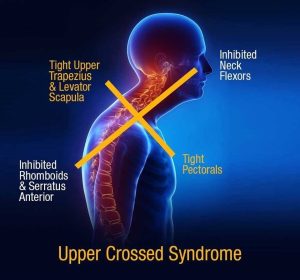What are the causes of upper cross syndrome
Upper cross syndrome
Upper cross syndrome is a postural imbalance characterized by tightness and weakness in specific muscle groups of the upper body. It typically involves a combination of tightness in the muscles at the front of the chest and neck (such as the pecs and anterior neck muscles) along with weakness in the muscles of the upper back and neck (such as the rhomboids, lower traps, and deep cervical flexors).


The term “upper cross” refers to the pattern of muscle imbalances that form an X-shaped pattern when viewed from the side. This imbalance can lead to rounded shoulders, a forward head posture, and an exaggerated curvature of the upper spine (kyphosis). Symptoms may include neck pain, shoulder pain, headaches, and decreased range of motion in the shoulders and neck.
The causes
Common causes of upper cross syndrome include poor posture, prolonged sitting, repetitive movements, and muscle imbalances developed from certain sports or activities.
- Prolonged sitting: Sitting for long periods, especially with poor posture, can lead to tightness in the chest muscles (pectorals) and hip flexors while weakening the muscles of the upper back and neck.
- Lack of exercise or improper training: Inadequate exercise or training that neglects important muscle groups, such as the muscles of the upper back and neck, can contribute to muscle weakness and imbalance.
- Poor ergonomics: Working or performing activities in environments that lack proper ergonomic support, such as an improperly adjusted workstation or using equipment that does not support proper posture, can contribute to upper cross syndrome.
- Stress: Psychological stress can lead to muscle tension, which may exacerbate the tightness in the chest and neck muscles associated with upper cross syndrome.
- Injury or trauma: Previous injuries or trauma to the neck, shoulders, or upper back can lead to compensatory muscle imbalances that contribute to upper cross syndrome.
- Pelvis and spinal misalignment: Loss of normal spinal curvature can be due to pelvis and spinal misalignment which will cause poor spinal biomechanic and muscle imbalance.
Conclusion
In conclusion, addressing these contributing factors through proper posture awareness, regular exercise targeting all muscle groups, ergonomic adjustments, stress management techniques, and appropriate rehabilitation after injuries can help prevent or alleviate upper cross syndrome.


